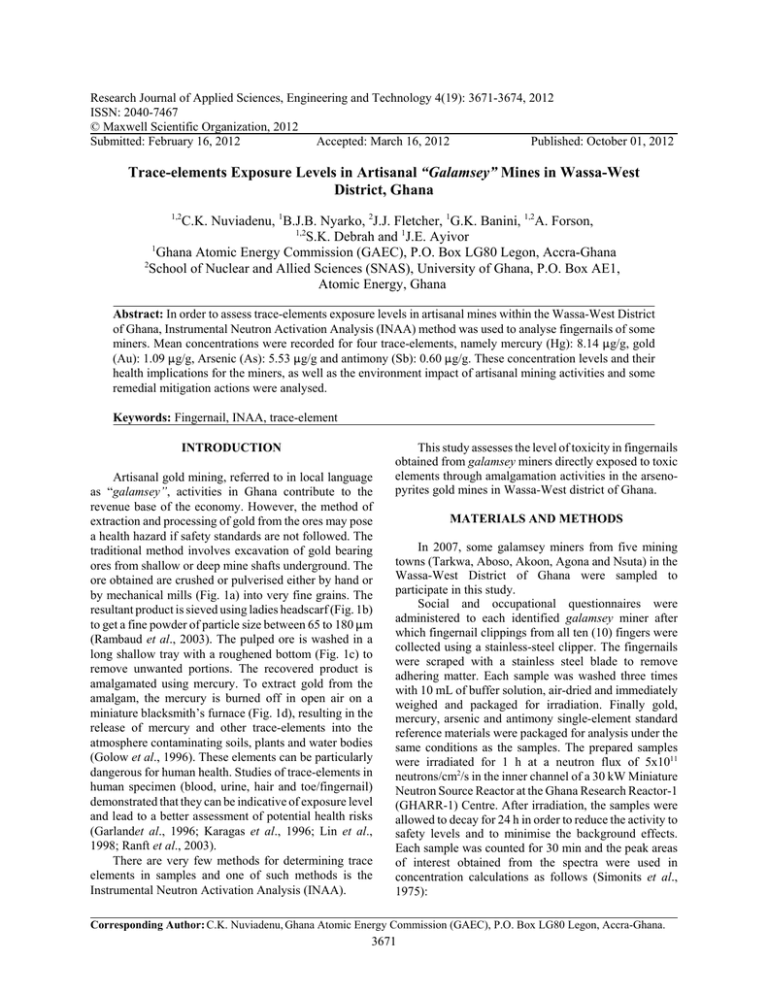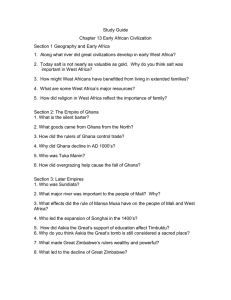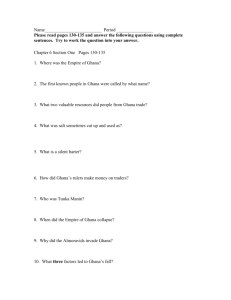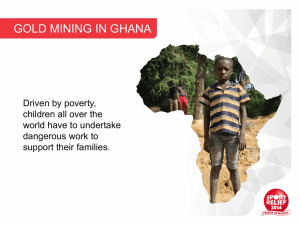Research Journal of Applied Sciences, Engineering and Technology 4(19): 3671-3674,... ISSN: 2040-7467
advertisement

Research Journal of Applied Sciences, Engineering and Technology 4(19): 3671-3674, 2012 ISSN: 2040-7467 © Maxwell Scientific Organization, 2012 Submitted: February 16, 2012 Accepted: March 16, 2012 Published: October 01, 2012 Trace-elements Exposure Levels in Artisanal “Galamsey” Mines in Wassa-West District, Ghana 1,2 C.K. Nuviadenu, 1B.J.B. Nyarko, 2J.J. Fletcher, 1G.K. Banini, 1,2A. Forson, 1,2 S.K. Debrah and 1J.E. Ayivor 1 Ghana Atomic Energy Commission (GAEC), P.O. Box LG80 Legon, Accra-Ghana 2 School of Nuclear and Allied Sciences (SNAS), University of Ghana, P.O. Box AE1, Atomic Energy, Ghana Abstract: In order to assess trace-elements exposure levels in artisanal mines within the Wassa-West District of Ghana, Instrumental Neutron Activation Analysis (INAA) method was used to analyse fingernails of some miners. Mean concentrations were recorded for four trace-elements, namely mercury (Hg): 8.14 :g/g, gold (Au): 1.09 :g/g, Arsenic (As): 5.53 :g/g and antimony (Sb): 0.60 :g/g. These concentration levels and their health implications for the miners, as well as the environment impact of artisanal mining activities and some remedial mitigation actions were analysed. Keywords: Fingernail, INAA, trace-element INTRODUCTION Artisanal gold mining, referred to in local language as “galamsey”, activities in Ghana contribute to the revenue base of the economy. However, the method of extraction and processing of gold from the ores may pose a health hazard if safety standards are not followed. The traditional method involves excavation of gold bearing ores from shallow or deep mine shafts underground. The ore obtained are crushed or pulverised either by hand or by mechanical mills (Fig. 1a) into very fine grains. The resultant product is sieved using ladies headscarf (Fig. 1b) to get a fine powder of particle size between 65 to 180 :m (Rambaud et al., 2003). The pulped ore is washed in a long shallow tray with a roughened bottom (Fig. 1c) to remove unwanted portions. The recovered product is amalgamated using mercury. To extract gold from the amalgam, the mercury is burned off in open air on a miniature blacksmith’s furnace (Fig. 1d), resulting in the release of mercury and other trace-elements into the atmosphere contaminating soils, plants and water bodies (Golow et al., 1996). These elements can be particularly dangerous for human health. Studies of trace-elements in human specimen (blood, urine, hair and toe/fingernail) demonstrated that they can be indicative of exposure level and lead to a better assessment of potential health risks (Garlandet al., 1996; Karagas et al., 1996; Lin et al., 1998; Ranft et al., 2003). There are very few methods for determining trace elements in samples and one of such methods is the Instrumental Neutron Activation Analysis (INAA). This study assesses the level of toxicity in fingernails obtained from galamsey miners directly exposed to toxic elements through amalgamation activities in the arsenopyrites gold mines in Wassa-West district of Ghana. MATERIALS AND METHODS In 2007, some galamsey miners from five mining towns (Tarkwa, Aboso, Akoon, Agona and Nsuta) in the Wassa-West District of Ghana were sampled to participate in this study. Social and occupational questionnaires were administered to each identified galamsey miner after which fingernail clippings from all ten (10) fingers were collected using a stainless-steel clipper. The fingernails were scraped with a stainless steel blade to remove adhering matter. Each sample was washed three times with 10 mL of buffer solution, air-dried and immediately weighed and packaged for irradiation. Finally gold, mercury, arsenic and antimony single-element standard reference materials were packaged for analysis under the same conditions as the samples. The prepared samples were irradiated for 1 h at a neutron flux of 5x1011 neutrons/cm2/s in the inner channel of a 30 kW Miniature Neutron Source Reactor at the Ghana Research Reactor-1 (GHARR-1) Centre. After irradiation, the samples were allowed to decay for 24 h in order to reduce the activity to safety levels and to minimise the background effects. Each sample was counted for 30 min and the peak areas of interest obtained from the spectra were used in concentration calculations as follows (Simonits et al., 1975): Corresponding Author: C.K. Nuviadenu, Ghana Atomic Energy Commission (GAEC), P.O. Box LG80 Legon, Accra-Ghana. 3671 Res. J. Appl. Sci. Eng. Technol., 4(19): 3671-3674, 2012 Fig. 1: (a) Side view of a belt operated crusher, (b): Miner sieving gold powder in an open topped pan using a mesh, (c): Wooden sluice boards for gravitational separation of gold bearing nuggets, (d): A typical artisanal gold refinery ρ sam ⎤ ⎡⎛ PA ⎞ ⎢⎣⎜⎝ t c ⎟⎠ CD⎥⎦ ( ρW ) std sam = ⎡⎛ PA ⎞ ⎤ ⎢⎣⎜⎝ t c ⎟⎠ CD⎥⎦ Wsam std Finally, statistical analyses of the results and their inferences were made. RESULTS AND DISCUSSION Demographic characteristics of the studied population (Table 1) indicate a relatively young group with about 75% having ages below 36 years. The number of years participants have been engaged (working experience) in the galamsey mining activities varied between 3 and 28. Trace-elements concentrations in the fingernails (Table 2) show great variations between subjects within each mining site and between mining sites. This could be attributed to a combination of factors: the stage(s) of involvement of individual miners in the mining processes (described above), the observance of safety standards and the number of years they have worked in the mines. These however were not established by a correlation study. A glance at statistical summary of the data (Table 3); reveals mean concentration values for the different traceelements with large standard deviations. Over 80% of the data points fall within one (1) standard deviation, making our data hardly normally distributed. Comparing trace-elements levels determined in this study with data available from previous studies on both Table 1: Demographic and other characteristics of the studied population Conditions Sample size Female subjects 9 Male subjects 21 Total subjects 30 Working experience: #5 years 11 Working experience: 6-10years 6 Working experience: >10 years 13 Age distribution (years) Median age 30 Range 17-58 25th, 75th percentiles 30, 36 25th, 75th percentiles: 30% of participants have ages below 30 years whiles 75% are less than 36 years old exposed and non-exposed subjects, some observations were made. A study on subjects from Dumasi in Ghana, revealed a mean Hg concentration in fingernails of 3.0 :g/g (range: 0.9-12.6 :g/g) for a control group and 8.5 :g/g (range: 1.4-55.7 :g/g) for the chronically exposed small-scale miners (Rambaud et al., 2003). The mean concentration of 8.14 µg/g (range: 1.09-37.45 µg/g) obtained in this present study appears in agreement with the values cited by Rambaud for the chronically exposed group. Average gold concentration of 0.58 :g/g (range: 0.27-2.05 :g/g) was reported in fingernails of apparently normal subjects, with higher concentrations in those who wore gold wedding bands (Kanabrocki et al., 1968). Compared with the previous findings, mean concentration of 1.09 :g/g (range: 0.06-5.74 :g/g) recorded in this work is about twice those reported for the non-exposed subjects. In a study based on analysis of fingernails from healthy individuals living in a relatively non-industrial 3672 Res. J. Appl. Sci. Eng. Technol., 4(19): 3671-3674, 2012 Table 2: Trace element concentration results of fingernail samples from Galamsey miners in Wassa-west district Concentration (:g/g) Concentration (:g/g) ----------------------------------------------------------------------------------------------------------------------Sample code Hg Au As Sb Sample code Hg Au As Sb Abs1-1 2.22±0.08 0.76±0.04 1.15±0.04 0.39±0.02 Nsu1 3.83±0.10 1.13±0.09 1.17±0.07 0.63±0.02 Abs1-2 8.53±0.11 0.44±0.03 25.88±0.87 0.60±0.03 Nsu2 3.58±0.08 0.06±0.01 2.09±0.10 0.08±0.01 Abs1-3 12.35±0.3 80.20±0.03 21.97±0.93 0.33±0.02 Nsu3 12.94±0.17 1.55±0.08 0.86±0.03 1.35±0.05 Abs1-4 4.21±0.11 0.80±0.04 12.39±0.66 0.76±0.04 Nsu4 27.74±0.31 0.47±0.07 3.84±0.14 0.43±0.03 Abs1-5 7.23±0.15 1.10±0.07 1.26±0.06 1.68±0.03 Tak1 1.19±0.06 0.08±0.01 0.31±0.04 0.08±0.01 Abs2-1 4.81±0.13 0.18±0.03 1.19±0.06 0.27±0.01 Tak2 1.09±0.06 0.06±0.01 0.24±0.05 0.08±0.01 Abs2-2 7.90±0.11 1.55±0.07 0.81±0.05 0.34±0.02 Akn1 37.45±0.82 5.74±0.11 24-.98±2.11 0.28±0.01 Abs2-3 6.72±0.13 0.08±0.01 3.84±0.19 0.33±0.02 Akn2 7.91±0.09 0.74±0.04 2.50±0.11 0.34±0.02 Abs2-4 1.09±0.06 0.07±0.01 0.98±0.08 0.69±0.04 Akn3 6.46±0.12 1.61±0.05 0.24±0.05 0.48±0.03 Abs2-5 9.14±0.13 2.11±0.09 7.91±0.27 1.04±0.03 Akn4 12.82±0.20 0.37±0.06 2.66±0.11 0.51±0.02 Abs3-1 9.21±0.17 0.94±0.05 2.16±0.09 1.11±0.06 Akn5 1.09±0.06 0.12±0.02 1.01±0.06 0.53±0.02 Abs3-2 1.09±0.06 0.17±0.02 4.27±0.12 0.86±0.03 Ago1 1.09±0.06 3.33±0.09 1.49±0.07 1.01±0.05 Abs3-3 1.09±0.06 0.88±0.04 3.61±0.17 1.58±0.07 Ago2 4.21±0.06 5.21±0.11 16.91±4.54 0.25±0.01 Abs3-4 15.02±0.2 20.70±0.06 5.60±0.11 0.12±0.01 Ago3 30.08±0.29 0.11±0.03 5.87±0.19 0.64±0.04 Abs3-5 1.09±0.06 0.93±0.06 3.27±0.10 0.72±0.03 Ago4 1.09±0.06 1.24±0.04 5.52±0.14 0.49±0.02 Table 3: Statistical summary of trace-elements concentrations Trace- Min Max GM Mean Stdev (:g/g) (:g/g) (:g/g) (:g/g) element (:g/g) Hg 1.09±0.06 37.45±0.82 4.61 8.14 9.11 Au 0.06±0.01 5.74±0.11 0.52 1.09 1.40 As 0.24±0.05 25.88±0.87 2.62 5.53 7.34 Sb 0.08±0.01 1.68±0.03 0.45 0.60 0.42 GM: Geometric mean; Mean: Arithmetic mean; Stdev: Standard deviation; Min: Minimum; Max: Maximum environment, (Hewitt et al., 1995) mean antimony (Sb) concentration of 0.05 :g/g was reported. In this present work, a mean value of 0.60 µg/g (range: 0.08-1.68 µg/g) was obtained. This is considerably higher than (about 10 times) those reported by Heiwitt. Geometric mean arsenic concentrations of 0.098 :g/g (range: 0.01-2.03 :g/g) and 0.090 :g/g (range: 0.01-2.57 :g/g) were reported in toenails from a basal cell carcinoma group and a squamous cell carcinoma group respectively (Karagas et al., 2001). In the present study arsenic (As) concentrations in fingernails ranged from 0.24 to 25.88 :g/g with a geometric mean of 2.62 :g/g. These are high values that could equally be of health concern. CONCLUSION All four elements (Hg, Au, As and Sb) detected in fingernails of the galamsey miners, in the Wassa-West District of Ghana, were on the average at concentrations that depict high exposure levels. Some individual concentrations were also critically high, raising health concerns. This study provided the opportunity to directly measure trace-elements in specimens collected from the exposed persons and also use fingernails as biomonitors of exposure level; which was usually a difficult task due to the reluctance of participants in giving out samples. It is recommended that routine health screening for populations and frequent monitoring programs be carried out in the mining areas by both the Ghana Health Service and the Environmental Protection Agency (EPA) to ensure best practises of safety and standard procedures. ACKNOWLEDGMENT The authors wish to thank the International Atomic Energy Agency (IAEA) for providing the standard reference materials. Support from technicians at the GHARR-1 is also appreciated. REFERENCES Garland M., J.S. Morris, G.A. Colditz, M.J. Stampfer, V.L. Spate, C.K. Baskett, B. Rosner, F.E. Speizer, W.C. Willet and D.J. Hunter, 1996. Toenail trace element levels and breast cancer: A prospective study. Am. J. Epidemiol., 144: 653-660. Golow, A.A., A. Schlueter and S. Amihere-Mensah, 1996. Distribution of arsenic and sulphate in the vicinity of ashanti goldmine at obuasi, Ghana. Bull. Environ. Contam. Toxically, 56: 703-710. Hewitt D.J., G.C. Millner, A.C. Nye and H.F Simmons, 1995. Investigation of arsenic exposure from soil at a superfund site. Environ. Res., 68: 73-81. Kanabrocki, E., L.F. Case, L.A. Graham, T. Fields, Y.T. Oester and E. Kaplan, 1968. Neutron activation studies of trace-elements in human fingernail. J. Nuclear Med., 9: 478-481. Karagas, M.R., J.S. Morris, J.E. Weis, V. Spate, C. Baskett and E.R. Greenberg, 1996. Toenail Samples as Indicator of Drinking Water Arsenic Exposure. Cancer Epidemiol Biomarkers Prev., 5: 849-852. Karagas, M.R., T.A. Stukel, J.S. Morris, T.D. Tosteson, J.E. Weis, S.K. Spencer and E.R. Greenberg, 2001. Skin cancer risk in relation to toenail arsenic concentration in US population-based case-control study. Am. J. Epidemiol., 153: 559-565. 3673 Res. J. Appl. Sci. Eng. Technol., 4(19): 3671-3674, 2012 Lin, T.H., Y.L. Huang and M.Y. Wang, 1998. Arsenic species in drinking water, hair, fingernails and urine of patients with blackfoot Disease. Journ. Toxicol Environ. Health A, 53: 85-93. Rambaud, A., C. Casellas, F. Portet, M. Babut, S.O. Sackey, N. Ankrah, R. Sekyi, C.A. Sackey, M. Potin-Gautier, S. Tellier and W. Bannerman, 2003. Assistance in Assessing and Reducing Mercury Pollution Emanating from Alluvial Gold Mining in Ghana. Phase II: UNIDO Report, US/GHA/02/006. Ranft, U., P. Miskovic, B. Pesch, P. Jakubis, E. Fabianova, T. Keegan, A. Hergemöller, M. Jakubis and M.J. Nieuwenhuijsen, 2003. Associations between arsenic exposure from a coalburning power plant and urinary arsenic concentrations in Prievidza District. Slovakia. Environ. Health Perspect, 111: 889-894. Simonits, A., F. De Corte and J. Hoste, 1975. Singlecomparator methods in reactor neutron activation analysis. J. Radio-anal. Chem., 24: 31-46. 3674






